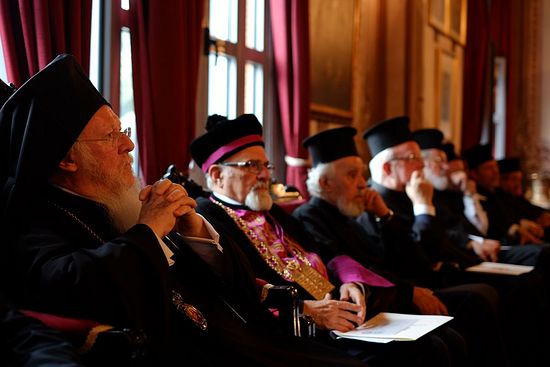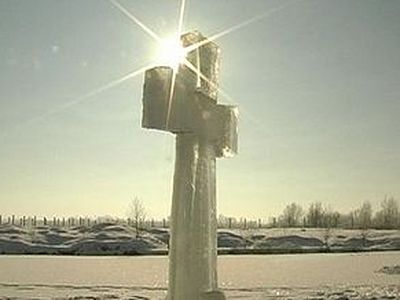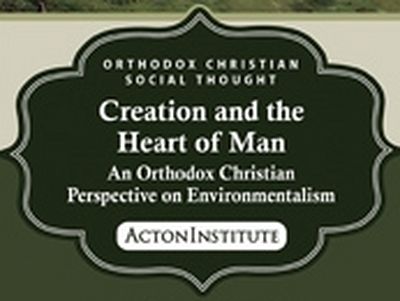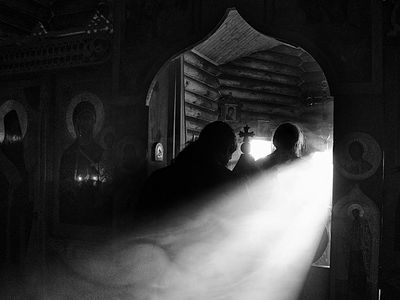Source: OMHKSEA
THEOLOGY, ECOLOGY AND THE ARTS
Reconciling Sacredness and Beauty
by Rev.John Chryssavgis
When medieval scholars maintained in their “tale of two truths” that science was called to observe the “Book of Nature” while religion was reflected in the “Book of Scripture,” they were struggling with a longstanding debate regarding the inconsistency between science and religion as well as the incongruence between creation and church. In his book Being as Communion, Metropolitan John [Zizioulas] of Pergamon, arguably the foremost Orthodox theologian today, compares these two different approaches, and asserts that:
Science and theology for a long time seemed to be in search of different sorts of truth, as if there were not one truth . . . This resulted in making truth subject to a dichotomy between the transcendent and the immanent.1
Indeed, since at least the time of the Enlightenment, white Europeans have grounded their comprehension – and their appreciation – of nature either on the “traditional” principles of religion and spirituality or else on the “liberal” promises of science and technology. The former seemingly looked backward – or upward – toward some divine or otherworldly prospect; the latter apparently looked forward – or downward – toward a worldly or human perspective, one based solely on reason and the tangible. One gravitated toward an apocalyptic surrender to or escapism from creation; the other inclined toward the pursuit of pleasure, power and profit. For centuries, this relationship between religion and science was tentative and tense. Both spoke with unrestrained and dogmatic authority; both enjoyed unconditional prestige and authority. It is still taking a long time for science and religion to forge a complementary relationship. Even today, when the science of climate change and the religious view of creation care command critical cooperation, the association is fraught with suspicion that religion and science might be using or misusing each other.
One of the primary and visionary goals of the ecological initiatives of the Ecumenical Patriarchate has been precisely the reconciliation of these two ways, which have long been separated and estranged. The individualistic and mechanistic approach to nature in the Middle Ages and Enlightenment invariably resulted in an arrogant dichotomy between religion and science by the church. For its part, if not due to its own conceit, science relegated religion to the sphere of mysticism and mythology. Both competed for the market of human happiness – one in the bliss of heaven, the other in the domination of earth.
Nevertheless, how can there be a double order or a double vision of creation? How can this world possibly be disconnected from the spiritual world without both sooner or later suffering, without both ultimately being desacralized? If they are to be true to themselves, both science and religion must accept that every revelation of reality – whether religious or scientific – can only make sense if the world is respected in its mysterious, holistic integrity. Religion and science alike must disabuse themselves of their exclusive, esoteric parlance, which render it difficult, if not impossible, to develop an ecological grammar or vocabulary that would involve all religions and all disciplines.
The living universe proposes and invites us to such an alternative, enlarged view of life, a more organic view of the world – not unlike that exposed with a wide-angle lens. It prevents us from – in fact, it prohibits – a narrow, self-indulgent, self-serving way. Instead, the world manifests itself as a celebration of the essential interconnection and interdependence of all things – what Maximus the Confessor (580-662) in the seventh century called a “cosmic liturgy.” What people conveniently overlook about the genesis story is that the sixth day of creation was not dedicated exclusively to Adam (Genesis 1.26), but shared with “living creatures of every kind; cattle and creeping things; and wild animals of every kind.” (Genesis 1.24)
There is more that unites than separates us, not only as human beings but also within the entire universe. This is a lesson we have learned only reluctantly in recent decades. Nevertheless, this alternative vision and worldview, this other way of being and living, should be more than just a political conviction or fashionable statement. It should become, as Metropolitan John has elsewhere said, “not an ethic, but anethos; not a program, but an attitude; not a legislation, but a culture.”2
And here, let me humbly submit, is where the arts come into play; here is where the word of literature and poetry, the world of photography and food, can inform both religion and science. For, beyond the estrangement between religion and science, we sometimes witness another paralyzing divorce: between religion and art. Religion and art should never neglect – still less should they betray – their innate and integral relationship. 3 Any disregard for their eternal interdependence and mutual interconnection can prove detrimental to both, while also rendering each of them permanently disabled and sterile. On the one hand, then, the arts cannot be reduced to a temporal or material preoccupation, incapable of transforming the ordinary to the extraordinary; on the other hand, religion should never misplace its melody, grace and spice, becoming incompetent to influence or inspire. The arts can be a bridge, whose goal is to transform nature into culture, to elevate the ephemeral to the eternal. Is not our aspiration to embrace and love matter, to lift up and refer creation – whether through the word of the writer, the paint of the artist, the note of the musician, the flicker of the photographer, or the ingredients of the chef – in an act of transformation and fulfillment, much like an Orthodox priest does in liturgy when bread and wine (and not simply grains and grapes) are offered in thanksgiving to the lord and creator of all life?
Neither religion nor the arts should – in fact, neither religion nor the arts can – silence one other. Theology needs more poetry; and the arts need more spirit. Because both express and both profess the deep- seeded nostalgia and at the same time yearning for “whatever is true and honorable, whatever is just and pure, whatever is beautiful and grace-filled.” (Philippians 4.8) Both are fellow ministers and passionate servants of the divine Word, “the alpha and the omega, who is and who was and who is to come.” (Revelation 1.8) Both “peer through a mirror dimly . . . in order to discern face to face.” (1 Corinthians 13.12) Both oscillate between the intimate and the distant, the immanent and the transcendent – what in theological jargon we would call the incarnational and the eschatological.
Who has not sensed a meeting of the worldly and the divine in Handel’s “Messiah” in the eighteenth century, van Gogh’s “Starry Night” in the nineteenth century, and Ansel Adams’ photographs of Yosemite in the twentieth century? Or what of the Sistine Chapel with the sublime in “The Creation of Adam” and the grotesque in “The Last Judgment”? Which of course also raises the question of how the arts depict the loss of connection between heavenly and earthly. And closer to “home,” albeit further back in time, recall the envoys of Prince Vladimir of Kiev (958-1015), standing beneath the dome of Haghia Sophia in ninth- century Constantinople and exclaiming: “We knew not whether we were in heaven or on earth!”
No wonder, then, that the oldest surviving Christian liturgy prays: “Every material and spiritual creature proclaims the magnificence of God.”4 And in the fourth century, Basil of Caesarea (330-379) believed that even the slightest detail of creation bore the mark of the Creator:
Look at a stone, and notice that even a stone carries some mark of the Creator. It is the same with an ant, a bee, a mosquito. The wisdom of the Creator is revealed in the smallest creatures. It is God who has spread out the heavens and stretched out the immensity of the seas. It is God who has also made the tiny hollow shaft of the bee’s sting.5
The same truth – discovered by science and discerned in theology – is also expressed outside of the theological world by the controversial twentieth-century Greek author Nikos Kazantzakis (1883-1957), whose work was regrettably misunderstood and maligned, even banned by the Vatican and condemned by the Church of Greece – I am only grateful that my own church, the Ecumenical Patriarchate, did not act likewise. Kazantzakis retains a powerful spiritual worldview of the divine seed in the world, whereby nature is the only premise and promise for either salvation or destruction; it is not a finished product, but a moving ground, a process of continuous self-transcendence and transformation:
Everything is an egg, and within it lies the seed of God, restlessly and sleeplessly active . . . With the light of my mind and the fire of my heart, I beset God’s watch – searching, testing, knocking to open the door in the stronghold of matter, and to create in that stronghold of matter, the door of God’s heroic exodus . . . For we are not simply freeing God in struggling with and ordering the visible world around us; we are actually fashioning God. Open your eyes, God is crying; I want to see! Be alert; I want to hear! . . . For to save something [whether a rock or a seed] is to liberate God within it . . . Every person has a particular circle of things – of trees, of animals, of people, of ideas – and the aim is to save that circle. No one else can do that. And if one doesn’t save, one cannot be saved . . . The seeds are calling out from inside the earth; God is calling out from inside the seeds. Set God free. A field awaits liberation from you, and a machine awaits its soul from you. And you can no longer be saved, if you don’t save them . . . The value of this transient world is immense and immeasurable: for it is on this world that God depends in order to reach us; it is in this world that God is nurtured and increased . . . Matter is the bride of my God: together they wrestle, together they laugh and together they mourn, crying through the nuptial chamber of the creation.6
Art can nurture the seed so that it is revealed in all its glory. Consider that egg yolk becomes part of the icons in the Orthodox Church or that the human body assumes the form of a tree in the quasi-sacramental “Take me to the Water,” one of Alvin Ailey’s (1931-1989) dances in his famous “Revelations.” This inviolable and venerable identification of the “beautiful” and the “sacred” is the quintessence of the first and last books of the Judeo- Christian Scriptures: the very meaning of the words and the very core of Genesis and Revelation.7 “Then I saw a new heaven and a new earth . . . And I saw the holy city, new Jerusalem, coming down out of heaven from God, prepared as a bride, adorned8 . . . And he who sat upon the throne said, ‘Behold, I make all things new.’ And in the Spirit he carried me away to a great, high mountain, and showed me the holy city . . . having the glory of God, its radiance like a most rare jewel, like jasper, clear as crystal . . . The foundations of the wall of the city were adorned with every precious stone: sapphire, agate, emerald, onyx . . . amethyst. And each of the twelve gates was made of a single pearl and the city street made of pure gold, transparent as glass . . . And in that city . . . the glory of God was its light, and its lamp was the Lamb. By its light shall all nations walk.” (Revelation 21.1-2,5, 10-11, 19-21, and 23-24)
Perhaps this is why we speak of “angelic” or “divine” beauty! Perhaps this is why the Greek word for beauty (κάλλος, kallos) implies a “calling” or “attraction.” Over the next two days, we look forward to being engaged by you as artists and activists. We anticipate the lessons you can offer about our vocation to hold and mold God’s gift of creation in a respectful and – why not? – prayerful way, with careful and compassionate eyes and ears and hands and tastes and scents; to help us discern how and when even the grotesque and absurd can probe the connection between the divine and creation. We are grateful in advance for your presence and guidance, for this liberation and revelation – this unveiling and unleashing – of the beauty of God in every corner of the world, to the last crystal of ice and the last speck of dust.
Notes:
1. New York: St. Vladimir’s Seminary Press, 1997, 119.
2. “Preserving God’s Creation: three lectures on theology and ecology,” King’s College London Theological Review, vol. 12, no. 1 (Spring 1989), 1–5; vol. 12, no. 2 (Autumn 1989), 41–45; vol. 13, no. 1 (Spring 1990), 1–5. Here at vol. 13, no. 1, 5.
3. See Stylianos Harkianakis (now Archbishop of Australia), “Religion and Art,” Nea Poreia, 1969, 191-200. [In Greek]
4. The Liturgy of St. James is celebrated twice a year in the Orthodox Church.
5. Commentary on Psalm 32,3 in PG 29.329.
6. Ascetic Exercises, Athens, 1979 (5th edition), 85-89. [Translation mine]
7. See Stylianos Harkianakis (now Archbishop of Australia), “The Relationship between Theological and Aesthetical Categories in the Revelation of John,” Nea Poreia, 1970, 133-142. [In Greek]
8. The “nuptial” vocabulary adopted by John the Divine to describe the “new Jerusalem” and echoed by Nikos Kazantzakis to describe the “liberation of matter” is strikingly similar.




